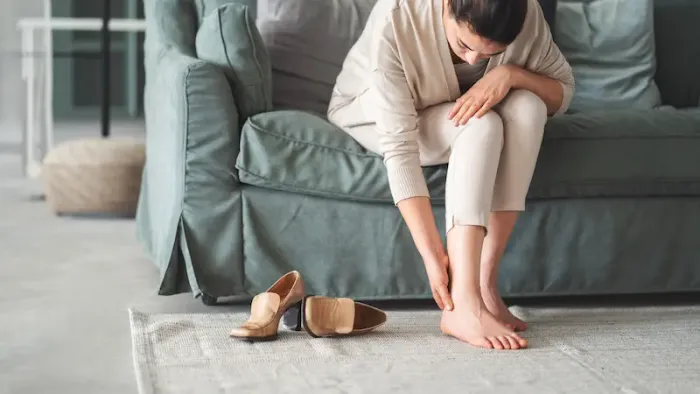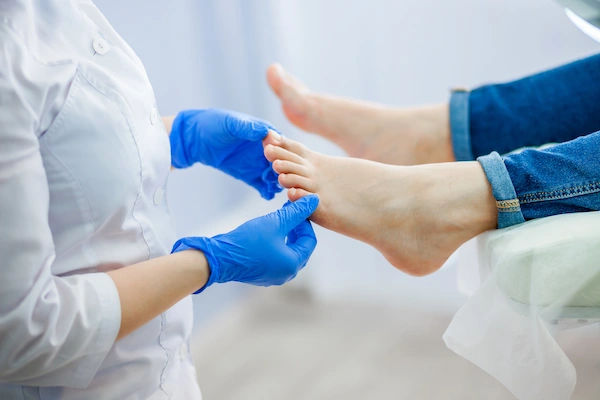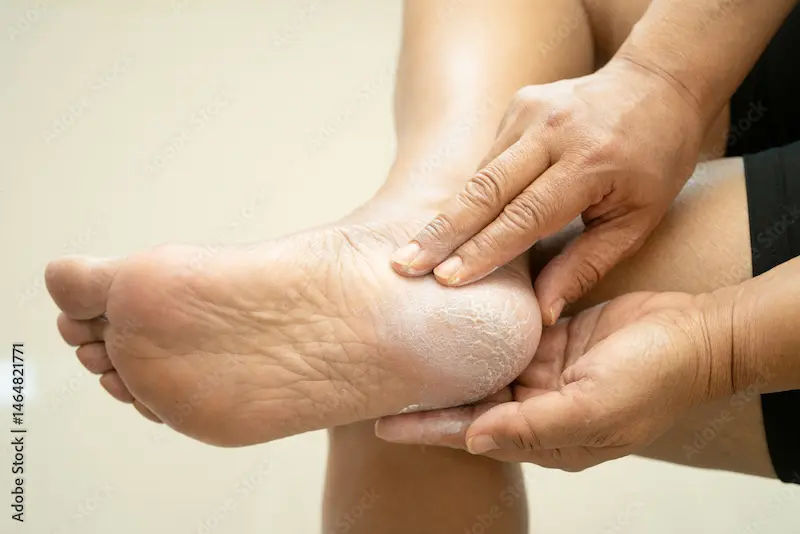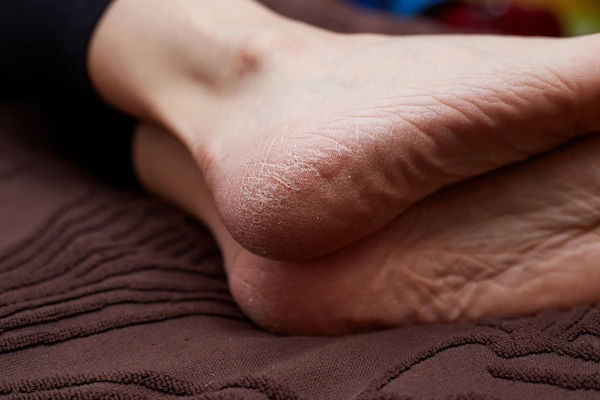Guide to Cracked Feet
Stop the pain! Our comprehensive guide shows you how to treat and prevent cracked heels and dry feet with effective home remedies, products, and expert tips. Get smooth, healthy feet today.

Written by Dr. Siri Nallapu
Reviewed by Dr. Rohinipriyanka Pondugula MBBS
Last updated on 24th Oct, 2025

Introduction
Dry, cracked feet can sneak up on anyone—one day your heels look a bit flaky, and the next you’re dealing with painful fissures that snag socks and make every step uncomfortable. The good news: most cases are fixable at home with the right products, a simple routine, and a few smart footwear changes. In this guide for the general public, we’ll explain why feet crack, what symptoms matter, and how to build a practical plan that actually heals your heels. You’ll learn which ingredients work (and at what strengths), how to use tools safely, and what shoe features protect your feet day to day. We’ll also cover special situations, like diabetes or athletic training, and when to see a clinician. If you’ve tried random tips without lasting results, this step-by-step approach will help you go from dry, cracked feet to smooth, comfortable skin—and keep it that way.
Cracked feet at a glance
Cracked feet—often called heel fissures—happen when thick, dry skin around the heels splits under pressure. You might first notice roughness, flaking, or yellowish callus around the rim of the heel. As dryness worsens, small lines form that can deepen into painful cracks. If the fissures bleed, feel tender to the touch, or catch on fabrics, your skin barrier is compromised and needs repair.
What heel fissures look and feel like:
• Thickened, dry, or scaly skin on the heels.
• Fine lines or deep splits that may bleed.
• White, yellow, or brown callus build-up at the edges.
• Soreness when standing, especially barefoot on hard floors.
• In advanced cases, redness or drainage suggests infection.
Cracked feet vs athlete’s foot or eczema:
• Athlete’s foot (tinea pedis) often causes itching, peeling between toes, and sometimes blistering; it’s a fungal infection and needs antifungals.
• Eczema (or dermatitis) on the feet tends to be itchy, inflamed, and may occur on arches or tops of feet, not just heels; it responds to moisturizers and sometimes topical steroids.
• Heel fissures are typically dry and thick rather than itchy and inflamed. That said, you can have both (e.g., dryness plus tinea pedis), so if scaling extends between toes or itching is prominent, have a clinician evaluate.
Consult a Top General Physician
Why feet crack?: the science
Your feet bear the weight of your entire body—often for hours on hard, dry surfaces. The outer skin layer (stratum corneum) protects you by building a thicker callus where friction and pressure occur. When the skin’s water content drops (low humidity, frequent hot showers, soaps that strip oils), this protective layer becomes stiff and less elastic. Then, daily forces from walking and standing cause the callus to split, creating heel fissures.
Everyday triggers:
• Open-back shoes and sandals allow the heel pad to expand sideways, increasing shearing forces that split dry skin.
• Prolonged standing at work, especially on hard floors, adds repetitive stress.
• Barefoot walking on abrasive surfaces (e.g., outdoor areas, rough tiles) promotes callus buildup.
• Low humidity (winter and air-conditioned spaces) accelerates water loss from skin.
Medical contributors:
• Skin conditions like eczema and psoriasis disrupt the skin barrier and can predispose to fissures.
• Fungal infections (athlete’s foot) can coexist with dryness and worsen scaling [6].
• Metabolic or endocrine issues (hypothyroidism, diabetes) increase risk via dry skin, neuropathy, or altered pressure distribution.
• Older age: the skin produces less natural moisturizing factor (NMF), and fat pads thin with time, increasing pressure and dryness.
Why cracks keep coming back: Over-aggressive removal of callus can trigger “rebound” hyperkeratosis—your body quickly rebuilds thick skin in response to perceived injury. Gentle, frequent care works better than infrequent aggressive debridement.
When to see a doctor?
While most cracked feet can be managed at home, watch for red flags:
• Persistent pain, bleeding fissures, or cracks that do not improve after 2–3 weeks of proper care.
• Signs of infection: redness, warmth, swelling, pus, bad odor, or fever.
• Numbness, tingling, or color changes in the feet (possible neuropathy or circulation problems).
• Extensive scaling between toes or blistering (suggesting athlete’s foot).
• Suspected eczema or psoriasis causing repeated flares.
Special considerations:
Diabetes, neuropathy, or peripheral arterial disease: Even minor cracks can become serious. Seek clinical guidance early; you may need a podiatry plan and shoe modifications.
Immunocompromised individuals or those with poor wound healing should not delay care.
If symptoms persist beyond two weeks, consult a doctor online with Apollo24|7 for further evaluation. If your condition does not improve after trying these methods, book a physical visit to a doctor with Apollo24|7. Early attention prevents small skin breaks from becoming infections.
The step-by-step home routine that heals cracked feet
A simple, consistent routine usually heals cracked heels within 2–4 weeks, faster for mild cases. The goal is to rehydrate the skin, gently thin thick callus, and protect the area from mechanical stress.
Daily 10-minute plan:
1) Short soak or warm shower (3–5 minutes): Briefly soften the skin. Avoid long hot soaks, which strip natural oils.
2) Gentle exfoliation: On damp skin, use a fine foot file or pumice stone with light strokes—no more than 60–90 seconds per heel. Focus on the edges of the callus, not raw cracks.
3) Apply a keratolytic heel balm: Choose urea 10–25%, lactic acid 10–12%, or salicylic acid 2–6% to soften and thin thick skin over time [1,2,5]. Rotate or combine with caution if sensitive.
4) Seal with an occlusive layer: Layer petrolatum (petroleum jelly) or a thick balm over the keratolytic to lock in moisture.
5) Sock occlusion: Wear clean cotton or moisture-wicking socks for at least 1–2 hours (overnight is ideal) to boost absorption.
Weekly “reset” plan:
• Once or twice weekly, extend the soak to 8–10 minutes and exfoliate slightly more (still gentle). Follow with your heel balm and occlusive.
• If a crack is deep and painful, apply a liquid bandage over the fissure before moisturizing the surrounding skin, or use a hydrocolloid bandage for 24–48 hours to protect and speed healing.
• Consider silicone heel cups during the day to reduce pressure and shear.
The “moisture sandwich” method:
• After a short soak, apply a humectant-rich product (e.g., glycerin/lactic acid lotion), then your keratolytic heel balm, then an occlusive like petrolatum. This layering pulls water into the skin, dissolves excess keratin gradually, and locks moisture in for hours. It’s especially effective overnight during the first 1–2 weeks.
Ingredients and products that work
Keratolytics (to thin thick, dry skin)
• Urea (10–25%): At 10–15%, it hydrates; at 20–25%, it softens and breaks down thick keratin. Urea is widely recommended for heel fissures and is effective in clinical practice. It’s gentle and pairs well with occlusives.
• Lactic acid (10–12%): An alpha-hydroxy acid that exfoliates and improves skin moisturization by increasing NMF. Useful for rough, scaly feet.
• Salicylic acid (2–6%): A beta-hydroxy acid that dissolves compacted keratin; effective for thick callus but can irritate sensitive or eczematous skin. Avoid open cracks.
Emollients and occlusives (to restore the barrier)
• Glycerin: A humectant that draws water into the outer skin layers; often combined with urea or lactic acid.
• Petrolatum (petroleum jelly): Excellent occlusive; reduces transepidermal water loss and supports barrier repair. Applying petrolatum nightly improved skin hydration and barrier function in multiple dermatology studies.
• Lanolin, shea butter, ceramide creams: Helpful for sealing and rebuilding the barrier.
Supportive aids
• Liquid bandage (cyanoacrylate): Forms a protective film over a deep fissure to reduce pain and contamination so it can heal.
• Hydrocolloid dressings: Provide a moist healing environment for shallow fissures.
• Silicone heel cups and gel socks: Cushion and reduce heel expansion and shearing forces; good for daytime use and during activity.
Pro tip: If skin stings with acids, step down to a lower concentration or switch to urea plus glycerin under a petrolatum seal. Consistency beats strength—daily use for 2–4 weeks is more important than using the strongest product once.
Tools, techniques, and what to avoid
Safe tools:
• Pumice stone: Use on damp skin with light pressure and short strokes. Rinse and dry the stone.
• Fine foot file (not razor): File gently on softened skin 2–4 times per week, then moisturize. The goal is to smooth—not to remove large layers.
What to avoid:
• Razor blades or “callus shavers”: These increase the risk of cuts, infection, and rebound callus. They’re particularly risky in diabetes or poor circulation.
• Aggressive chemical peels: “Foot peels” can over-exfoliate and disrupt the barrier, leading to sensitivity and, ironically, more cracking.
• Long hot soaks and strong soaps: They strip oils and worsen dryness.
Technique matters:
• File after softening (short soak), not on completely dry skin.
• Spend 60–90 seconds per heel; stop at the first sign of warmth or irritation.
• Always follow exfoliation with a keratolytic and then an occlusive.
• If you have neuropathy, avoid at-home filing and see a clinician for debridement.
Unique insight: Think “maintenance, not makeover.” The skin on your feet is designed to protect you; a thin, flexible callus is normal and helpful. Your mission is to keep it supple and smooth—not to erase it completely.
Footwear and lifestyle shifts
Shoes can make or break your results. When the heel pad spreads sideways in open-back shoes, the rim of dry skin splits more easily.
Shoe features to prioritize:
• Closed-back shoes with a firm heel counter to limit heel expansion.
• Cushioned midsoles (EVA or similar) that absorb impact without being too soft; overly soft midsoles may bottom out and increase shear.
• Slight heel-to-toe drop (modest lift) to reduce direct heel loading if you stand a lot.
• Outsole grip to reduce slippage and micro-tears.
• Roomy toe box to prevent an altered gait that overburdens the heel.
Socks and inserts:
• Moisture-wicking socks help keep feet dry if you sweat (excess moisture can also degrade the barrier).
• Gel-lined socks or silicone heel cups reduce pressure and friction on healing fissures.
• Consider orthotic inserts if you have high arches or heel pain, altering your stride.
Lifestyle habits:
• Limit barefoot time on hard, abrasive surfaces.
• Use a bath mat and slippers with grip to avoid slips (fissures hurt more when you tense your feet to prevent falls).
• Hydrate and use a humidifier in winter to counter low ambient humidity.
Unique insight:
Try the “two-shoe strategy”—a supportive closed-back pair for most of the day and a cushioned house shoe or slipper for floors at home. This reduces cumulative mechanical stress on the heels during the day and evening.
Special situations
Diabetes and neuropathy:
• Even small cracks can allow bacteria in, leading to serious infections. Reduced sensation means you may not feel worsening fissures. Prioritize prevention, daily inspection, and professional care for debridement.
• Avoid at-home blades and aggressive filing. Keep skin moisturized and protected with silicone heel cups.
• If you notice redness, warmth, or drainage, seek care promptly. People with diabetes should consider periodic foot checks with a clinician.
Athletes and runners:
• Repetitive impact and sweat can degrade the skin barrier. Use urea-based creams after showering, then a lighter occlusive. Before runs, a thin layer of anti-friction balm around the heel rim can reduce shear.
• Rotate shoes so midsoles can rebound; replace worn-out footwear to maintain cushioning.
• Address any fungal infections between toes promptly with antifungals to prevent spread and barrier damage.
Older adults and pregnancy:
• Older adults produce less NMF and often have drier feet; prioritize humectants (urea, glycerin) and petrolatum occlusion at night.
• During pregnancy, fluid shifts and ligament laxity can change foot mechanics; opt for supportive, closed-back shoes and avoid harsh keratolytics if your skin is more sensitive. Ask your clinician before starting strong acids.
Kids with cracked feet:
• Common after the summer sandal season. Choose milder concentrations (e.g., 10% urea) and focus on occlusion (petrolatum + socks) at night. Avoid salicylic acid on young children unless advised by a clinician.
Unique insight: Match your regimen to your activity cycle. On heavy activity days, emphasize protection (anti-friction balm, heel cups). On recovery days, emphasize repair (keratolytics + occlusion).
Prevention checklist and seasonal plan
Daily
• Short, warm (not hot) shower; gentle cleanser on feet.
• Apply urea or lactic acid cream to heels; seal with petrolatum at night.
• Wear closed-back, supportive shoes with moisture-wicking socks.
Weekly
• One to two gentle exfoliation sessions with a pumice or fine file.
• Inspect heels for early lines and seal any micro-cracks with a liquid bandage.
Summer plan
• Limit open-back sandals; when worn, use gel heel pads or choose models with a supportive heel strap.
• Rinse feet after beach/pool; re-apply moisturizer promptly to counter salt/chlorine dryness.
Winter plan
• Use a room humidifier and apply thicker occlusives nightly.
• Avoid very hot showers and harsh soaps; both strip oils and worsen dryness.
Unique insight: Keep a “sink-side set” (file, keratolytic, petrolatum, socks) ready. Reducing friction to 30 seconds of setup time makes consistency much more likely.
Troubleshooting: if cracks won’t heal
If you’ve followed a consistent routine for 2–3 weeks and still have painful, deep fissures, consider the following:
• Hidden triggers: Are you still wearing open-back shoes most days? Standing on hard floors for long shifts? Increase cushioning and support.
• Product mismatch: If strong acids sting, switch to urea + glycerin + petrolatum. If your skin is very thick, try a higher urea (20–25%) for 2 weeks before stepping down.
• Infection or skin condition: Scaling between toes, itchiness, or redness suggests tinea pedis (use an OTC antifungal and see a clinician if persistent). Inflamed plaques on the heels might be psoriasis or eczema.
• Medical contributors: Diabetes, hypothyroidism, nutritional deficits, or vascular issues can impede healing. Apollo24|7 offers a convenient home collection for tests like HbA1c or thyroid profile if your clinician recommends them.
If your condition does not improve after trying these methods, book a physical visit to a doctor with Apollo24|7. Early, targeted care prevents complications.
Conclusion
Cracked feet are common, uncomfortable, and—most importantly—very treatable. By understanding what’s happening in your skin and addressing both the dryness and the mechanical stress that cause fissures, you can break the cycle for good. A short daily routine (soften, gently exfoliate, apply a keratolytic cream, then seal with an occlusive and socks) delivers the biggest results in the least time. Supportive, closed-back shoes and small lifestyle tweaks protect your heels so they can heal. Choose well-studied ingredients like urea, lactic acid, and salicylic acid at appropriate strengths, and use protective aids like liquid bandages or silicone heel cups when needed. If your feet aren’t improving—or if you have diabetes, a possible infection, or other risk factors don’t wait. Getting professional guidance early prevents complications and speeds recovery. If symptoms persist beyond two weeks, consult a doctor online with Apollo 24|7 for further evaluation. And if root causes like diabetes or thyroid issues are suspected, Apollo 24|7 offers a convenient home collection for tests such as HbA1c or thyroid profile, as advised by your clinician. With a little consistency and the right tools, smooth, comfortable feet are well within reach now and all year round.Consult a Top General Physician
Consult a Top General Physician

Dr. Harshendra Jaiswal
General Physician/ Internal Medicine Specialist
12 Years • MBBS , MD (General medicine)
Kolkata
108 DHANA DHANVANTARI Clinic, Kolkata
(25+ Patients)
Dr P Sai Avinash
General Physician/ Internal Medicine Specialist
7 Years • MBBS
Bengaluru
Apollo Medical Center, Marathahalli, Bengaluru

Dr Bhargav Vuppumalla
General Physician/ Internal Medicine Specialist
5 Years • MBBS MD GENERAL MEDICINE
Bengaluru
Apollo Medical Center, Marathahalli, Bengaluru

Dr. M L Ezhilarasan
General Practitioner
6 Years • MBBS
Visakhapatnam
Apollo 24|7 Clinic - Andhra Pradesh, Visakhapatnam

Dr. Vivek D
General Physician
4 Years • MBBS
Bengaluru
PRESTIGE SHANTHINIKETAN - SOCIETY CLINIC, Bengaluru
Consult a Top General Physician

Dr. Harshendra Jaiswal
General Physician/ Internal Medicine Specialist
12 Years • MBBS , MD (General medicine)
Kolkata
108 DHANA DHANVANTARI Clinic, Kolkata
(25+ Patients)
Dr P Sai Avinash
General Physician/ Internal Medicine Specialist
7 Years • MBBS
Bengaluru
Apollo Medical Center, Marathahalli, Bengaluru

Dr Bhargav Vuppumalla
General Physician/ Internal Medicine Specialist
5 Years • MBBS MD GENERAL MEDICINE
Bengaluru
Apollo Medical Center, Marathahalli, Bengaluru

Dr. M L Ezhilarasan
General Practitioner
6 Years • MBBS
Visakhapatnam
Apollo 24|7 Clinic - Andhra Pradesh, Visakhapatnam

Dr. Vivek D
General Physician
4 Years • MBBS
Bengaluru
PRESTIGE SHANTHINIKETAN - SOCIETY CLINIC, Bengaluru
More articles from Foot Cracks
Frequently Asked Questions
1) What is the best heel balm for very dry, cracked feet?
Look for heel balms with urea 20–25% or lactic acid 10–12% to soften thick skin, paired with an occlusive like petrolatum to seal in moisture. Urea cream for heels is a reliable first choice.
2) Can I use a foot file on cracked feet?
Yes, but be gentle. File only after a short soak, avoid the open crack, and stop after 60–90 seconds. Always follow with a keratolytic and an occlusive. Diabetic foot care tip: avoid at-home blades or aggressive filing; see a clinician [3,7].
3) How do I tell if it's athlete's foot vs dry skin?
Athlete’s feet often itch and peel between toes and may blister; dry, cracked feet usually involve thick callus on heels and soreness, not itch. If in doubt, use an antifungal for 1–2 weeks or see a clinician [6].
4) How long does it take to heal heel fissures?
Mild cases: 1–2 weeks with daily care. Moderate cases: 2–4 weeks. Persistent or painful fissures need medical evaluation. If your condition does not improve, book a physical visit to a doctor with Apollo24|7.
5) Are open-back shoes really that bad for cracked heels?
They increase heel pad expansion and shear, which can split dry callused skin. If you wear them, limit duration and use heel cups or choose models with a supportive heel strap.


